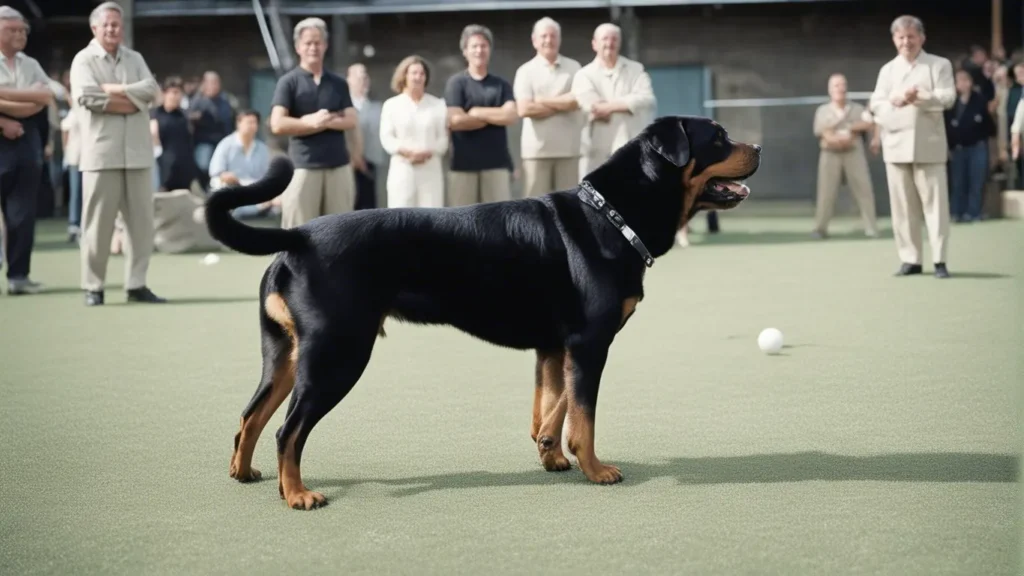With their imposing stature and intense gaze, Rottweilers naturally command attention wherever they go. However, these powerful dogs have gained an unfair reputation for aggression that often does not align with reality.
While isolated incidents of Rottweiler attacks certainly exist, it is wrong to paint the entire breed with the same brush. Like humans, each dog has a unique personality shaped by genetics, upbringing, and life experiences. Rottweilers can become devoted, calm companions with proper training, socialization, and responsible ownership.
To provide an accurate perspective on Rottweiler’s temperament, we must examine why aggression stereotypes emerged, what influences their behavior, and most importantly, how to prevent issues through proper care. By distinguishing fact from fiction, we can debunk myths about inherent aggression and promote responsible Rottweiler ownership.
Table of Contents
- 1 Understanding the Origins of Rottweiler Aggression Stereotypes
- 2 Key Factors That Contribute to Rottweiler Aggression
- 3 Preventing Aggression Through Proper Care and Handling
- 4 Why Rottweilers Do Not Deserve Their Bad Reputation
- 5 Recognizing Early Signs of Aggression
- 6 Promoting Responsible Rottweiler Ownership
- 7 Related posts:
- 8 How Fast Can A Rottweiler Run?
- 9 Are Rottweilers good for jogging?
- 10 Rottweilers Running
- 11 Rottweiler Breed Guide: Characteristics, Care & More
Understanding the Origins of Rottweiler Aggression Stereotypes
Before assessing Rottweiler’s aggression, it is essential to understand why these stereotypes emerged in popular culture. A combination of history, media portrayals, and improper care have unfairly contributed to their reputation.

Built for Guarding and Protecting
Rottweilers were originally bred in Germany to guard and protect livestock. Their robust size and alert nature made them excellent guard dogs. They would patrol properties and defend cattle from predators or thieves.
This protective instinct is deeply ingrained in Rottweilers. While advantageous in their original roles, those traits can become problematic in modern society without proper management. Guarding behaviors directed toward unfamiliar people or animals require guidance and boundaries from owners.
Media Sensationalism and Bias
Another factor in the aggressive image of Rottweilers is sensationalized media coverage. News reports disproportionately feature Rottweiler attacks versus positive stories. This lopsided coverage stems from inherent biases about particular breeds being more newsworthy when aggression occurs.
In reality, Rottweilers rank average in aggression when compared with other breeds. However, media outlets capitalize on existing stereotypes about “dangerous dogs” to generate interest. This cycle further perpetuates public misconceptions about inherent aggression in the breed.
Lack of Training and Socialization
Insufficient training and socialization during pivotal developmental stages often contribute to undesirable behaviors in Rottweilers, including aggression. Without proper guidance, they are left to rely on innate instincts, which can lead to overprotectiveness and poor social skills.

Owners who fail to invest time in positively shaping their Rottweiler’s behavior through rewards-based training set the stage for potential issues. Well-socialized and trained Rottweilers are far less likely to display unwarranted aggression.
By recognizing why certain stereotypes developed, we can better evaluate aggression triggers objectively and truthfully. Blame should be directed at owners who fail to manage natural behaviors and provide adequate care.
Key Factors That Contribute to Rottweiler Aggression
While many myths surround Rottweiler aggression, several proven factors can increase risks if not adequately addressed by owners. Knowing these influences provides the insight needed to manage them effectively.
Lack of Socialization
Insufficient socialization during puppyhood is a significant contributor to unwarranted aggression. Rottweilers who are not adequately exposed to various people, animals, and environments can become fearful or reactive.

Socialization involves gradually introducing your Rottweiler to new sights, sounds, smells, and experiences in controlled settings. Exposing them to people of diverse ages, appearances, and backgrounds helps build confidence and appropriate social skills. This prevents perceiving novel stimuli as threatening.
Owners who isolate puppies or fail to socialize adequately set the stage for fear-based aggression later in life. While genetics play a role, socialization profoundly impacts how a Rottweiler perceives and interacts with the world.
Poor Health or Pain
Medical conditions resulting in pain or discomfort often cause aggression when dogs feel threatened or mishandled. Just like humans, dogs will protect themselves if hurt or unwell and may snap when approached.
Arthritis, bone fractures, muscle strains, dental disease, cancer, and other ailments can influence temperament changes. While medication can help relieve pain itself, behavior modification training may be needed to overcome new aggressive patterns that formed.
Owners should watch for signs of physical distress and have regular veterinary checkups. Rule out medical issues before addressing problem behaviors. No training will be practical unless underlying pain or illness is resolved first.

Lack of Proper Training
Insufficient or harmful training methods also contribute to aggression issues. Rottweilers require dedicated, positive reinforcement training to promote good manners and impulse control.
Punishment-based techniques involving physical corrections or intimidation often backfire by increasing anxiety and fear. This makes dogs more prone to biting when feeling threatened during handling or modification.
Consistent positive training is crucial for teaching alternative behaviors to replace inappropriate aggression. Owners who fail to train their Rottweiler through rewards-based methods actively miss the opportunity to shape temperament during essential development stages.
Genetic Predisposition
While not the sole determiner of aggression, genetic predisposition does play a contributing role. Responsible Rottweiler breeders aim to select breeding dogs with stable temperaments and stress tolerance carefully.

However, some breeders ignore temperament in breeding selections and produce puppies with greater fearfulness or reactivity. Working with a reputable breeder who prioritizes health and temperament helps stack the odds in your favor.
Regardless of genetics, proper care and training are needed to manage natural protectiveness and encourage desirable behaviors. Rottweilers should never be condemned simply for being born a certain way.
Preventing Aggression Through Proper Care and Handling
We can focus on prevention through proper care and handling techniques now that critical factors have been identified. Conscientious owners should integrate these best practices into Rottweiler’s daily routine and training regimen.
Invest in Early Socialization
Preventing unwarranted aggression starts with dedicated socialization as early as possible. Rottweiler puppies who meet diverse people, dogs, and environments adjust better as adults than isolated dogs.
Gradually introduce your puppy to new sights, sounds, and situations to build confidence. Let them interact with puppy play groups and friendly adult dogs to learn good social skills. Continue socialization into adulthood to maintain desirable behaviors.
Commit to Consistent, Positive Training
Consistent positive reinforcement training is essential for teaching good manners and impulse control and addressing problem behaviors like aggression. Reward behaviors you want to see more of using treats, praise, play, and access to toys or activities.

Set clear boundaries and have realistic expectations for your Rottweiler’s behavior. Use force-free techniques focused on reinforcing desirable responses. Never use punishment, intimidation, or physical corrections that could worsen aggression.
Address Any Underlying Medical Issues
Rule out pain, discomfort, or illness as a potential cause of aggression. Be attentive to temperament, posture, appetite, or behavior changes that could indicate a medical problem. Have your veterinarian examine your Rottweiler and address any health issues.
Medication can help relieve pain and make training easier once the underlying ailment is treated. Be patient and allow time for rehabilitation as your dog’s condition improves before continuing behavior training.
Provide Proper Exercise and Mental Stimulation
Ensure your Rottweiler receives enough physical exercise and mental stimulation daily to prevent boredom-induced behavior problems. Long walks, playtime, sports, and interactive puzzle toys satisfy the natural needs of an active working breed.
A tired dog is a well-behaved dog. Establish a consistent routine and incorporate both physical and mental exercise. Well-exercised Rottweilers are less likely to display hyperactivity that leads to impulsive aggression.
Avoid Stress Triggers
Pay attention to situations that evoke anxiety or fear in your Rottweiler and work to minimize exposure to those stress triggers. If unfamiliar visitors make them uneasy, keep initial introductions low-key and have guests offer tasty treats.

Limit interactions with perceived threats based on your dog’s unique temperament. With time and positive associations, many triggers can be overcome. Preventing or removing stressors reduces reactive behavior.
Why Rottweilers Do Not Deserve Their Bad Reputation
Despite the stubborn persistence of Rottweiler aggression myths, the reality does not support condemning this entire breed. Like any dog, their behavior is shaped predominantly by genetics, socialization, training, and responsible ownership.
With proper care, Rottweilers exhibit steadfast devotion and a calm, confident demeanor. Their natural protectiveness makes them excellent service dogs, guiding blind people or alerting them to seizures. Their intelligence and eagerness to please enable success in search and rescue work, competitive dog sports, and police K9 programs.
Dogs should be judged on their merits. While certain dogs of any breed can be unstable or dangerous when handled irresponsibly, it is unjust to pre-judge an entire species based on isolated incidents. Rottweilers have as much potential to be model canine citizens as any other breed.
Dispelling Damaging Myths About Rottweiler Aggression
To overcome stigma, we must confront the common myths about inherent aggression in Rottweilers that still permeate public opinion and media portrayals. Understanding why these myths persist allows us to counter them with facts.
Myth: Rottweilers Turn On Owners Unexpectedly
Reality: Dogs almost always exhibit warning signs before resorting to biting. Owners often miss subtle body language indicating discomfort, stress, or fear before the bite. Surprise attacks out of nowhere rarely occur in stable dogs.

Myth: Rottweilers Have a Stronger Bite Than Other Breeds
Reality: Studies show Rottweiler jaw strength averages around 328 pounds of bite pressure, which is on par with German Shepherds. Several other breeds surpass Rottweilers. Genetics impact bite force, not breed labels.
Myth: Rottweilers Are More Dangerous Than Other Dogs
Reality: No scientific evidence indicates Rottweilers bite or attack more frequently than other breeds. Their large size and strength make injury potential greater IF a bite occurs. Proper handling minimizes any elevated injury risks.
Myth: Rottweilers Turn Aggressive At Around 2 Years Old
Reality: There is no inherent age where Rottweilers suddenly become aggressive if appropriately raised. They reach social maturity around two years old and demand more training. Owners must reinforce manners and boundaries as dogs mature.
By dismantling these myths with facts, we can reshape public perceptions. Spread accurate information when discussing Rottweiler’s temperament with others to dispel ingrained misconceptions.

Recognizing Early Signs of Aggression
Stopping aggressive behavior in its tracks requires vigilance from owners to recognize subtle early warning signs. While some dogs may attack without warning, most provide body language clues that go ignored.
Signs of impending aggression or distress include:
- Tense or nervous body posture
- Flattened ears
- Whale eye (exposing the whites)
- Yawning repeatedly
- Lip licking or tongue flicking
- Growling or deep rumbling
- Excessive panting
- Piloerection (raised hackles)
- Avoiding eye contact
- Sudden stillness or freezing
If your Rottweiler displays these signals in a concerning context, create distance from the stressor. Do not punish them or force interactions that make them uncomfortable. Redirection to a positive activity can help defuse tension.
Note situations that trigger these responses so you can work on changing those associations through desensitization training. Catching problems early better allows you to intervene with constructive activity.
Steps For Managing Existing Aggression Issues
If your Rottweiler already exhibits unwarranted aggression, take swift action. Managing existing issues requires professional guidance and consistent behavior modification training.

Start by having your veterinarian give your dog a thorough health exam to identify potential pain sources. Rule out underlying medical conditions before addressing the behavior itself.
Next, contact an experienced certified trainer or board-certified veterinary behaviorist. Avoid attempting overly harsh corrections that could worsen the problem. This is a job for qualified professionals only.
With their help, implement a customized behavior modification plan using desensitization, counterconditioning, and positive reinforcement. Change your dog’s negative associations with triggers to create a more positive emotional response.
Remain realistic about your dog’s progress and limitations. Some dogs can never fully be trusted in specific contexts. Manage your Rottweiler responsibly by avoiding high-risk situations that bring out unwanted aggression.
If problems persist despite your best efforts at behavior training, consult your veterinarian about prescribing anti-anxiety or other medications. Medical intervention coupled with training gives the best chance for managing aggressive tendencies.
Promoting Responsible Rottweiler Ownership
Prospective Rottweiler owners must fully understand the commitment involved before bringing one home. Preventing aggression starts with selecting the right dog and providing proper care from day one.

Research Breed Traits
Learn this breed’s history, purpose, temperament traits, and activity requirements before deciding if a Rottweiler suits your lifestyle. Their guarding instincts and strength demand an experienced owner fully dedicated to training and exercise needs.
Choose Your Breeder Carefully
Locate a responsible breeder focused on health and temperament. Meet the puppy’s parents when possible to evaluate their friendliness and tolerance. Responsible breeding reduces the chances of inheriting unstable genes.
Commit to Training from the Start
Enroll your Rottweiler puppy in dedicated training classes right away. Learn positive reinforcement techniques. Socialize them extensively to prevent fear-based behaviors. Maintain training throughout their lifetime.
Provide Proper Exercise and Stimulation
Give your energetic Rottweiler adequate outlets with regular exercise, playtime, food puzzles, obedience practice, and more. A tired dog is a well-behaved dog less prone to acting out.
Manage Protective Instincts
Be vigilant for contexts where their guarding tendencies surface and redirect their focus to a more positive behavior. Reinforce that you are the pack leader and will handle perceived threats.

Rottweilers Can Make Loyal Companions
Despite the intense myths surrounding Rottweiler aggression, these intelligent dogs can thrive as ideal companions with proper leadership, training, and care. Take time to know your personal dog’s unique temperament honestly.
While certain lines or individuals may be prone to unstable behavior, an entire breed should never be condemned for isolated incidents. Any dog can become dangerous in the wrong hands. By promoting responsible practices, we can ensure Rottweilers receive the understanding and compassion they deserve.